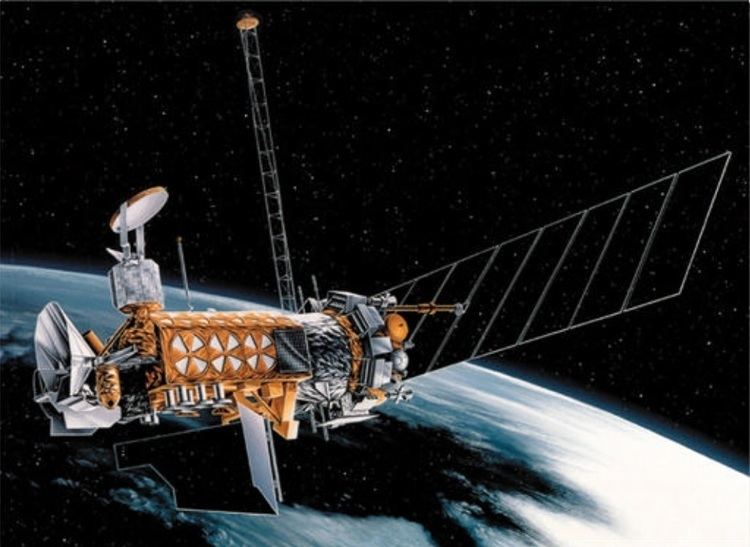 | ||
Defense meteorological satellite program dmsp launch
The Defense Meteorological Satellite Program (DMSP) monitors meteorological, oceanographic, and solar-terrestrial physics for the United States Department of Defense. The program is managed by the Air Force Space Command with on-orbit operations provided by the National Oceanic and Atmospheric Administration. The (originally classified) mission of the satellites was revealed in March 1973. They provide cloud cover imagery from polar orbits that are sun-synchronous at nominal altitude of 450 nautical miles (830 km).
Contents
- Defense meteorological satellite program dmsp launch
- Defense meteorological satellite program
- History
- 2015 explosion and debris field
- 2016 failure of DMSP 19
- Launch history
- Block 1
- Block 2
- Block 3
- Block 5D
- References

Defense meteorological satellite program
History

During the 1960s, one of the most important projects that the United States civil space program was involved in dealt with meteorology and weather forecasting. Unbeknownst to many, the U.S. military services were also starting up a weather satellite program. This program, the DMSP, would relay important weather and climate data to the military for more effective operations. From the onset of the DMSP program, knowledge of its existence was limited to "need-to-know" personnel. The United States Congress had assigned a substantial budget towards the civil weather satellite program; if knowledge of a second military program came out, it would have been hard for the military to justify it.

Initial operations of early DMSP systems provided radio return of cloud-cover imagery for planning of U.S. high-resolution photographic reconnaissance and surveillance missions, which utilized film-return systems. DMSP satellites operated in a sun-synchronous orbit; passing over the north and south poles, the satellite would see different strips of the Earth at the same local time each day. The DMSP satellites had periods of roughly 101 minutes, so they would orbit the Earth 14.3 times in 24 hours. This period combined with the sun-synchronous orbit would have the satellite pass over the whole surface of the planet twice a day.

The images acquired were relayed to the Earth and received by two command and readout stations established at retired Nike missile sites located near Fairchild Air Force Base, Washington and Loring Air Force Base, Maine. From these sites, the images were then sent to Air Force Global Weather Central (AFGWC) located at Offutt Air Force Base, Nebraska. Images would then be processed, forming a mosaic representing the cloud patterns that were observed from the orbiting satellites. Meteorologists could then provide flight crews and other commanders with up-to-date observations for their particular missions. Further advancements enabled data to be collected in the visual spectrum down to a half-moonlit scene. Infrared processing enabled night viewing. Other enhancements increased on-board processing; this includes multiple on-board computers and expanded power requirements.
Now in its fifth decade of service, the DMSP program has proven itself to be a valuable tool in scheduling and protecting military operations on land, at sea, and in the air. In December 1972, DMSP data was declassified and made available to the civil scientific community. On June 1, 1998 the control and maintenance of the satellites were transferred to National Oceanic and Atmospheric Administration (NOAA) in order to reduce costs.
2015 explosion and debris field
On 3 February 2015, the 13th DMSP satellite—DMSP-F13, launched in 1995—exploded while in a sun-synchronous polar orbit leaving a debris field of at least 43 to 100 large fragments and more than 50,000 pieces smaller than 1 millimeter. The US Air Force Joint Space Operations Center at Vandenberg Air Force Base, California is monitoring the expanding debris field, and "will issue conjunction warnings if necessary."
2016 failure of DMSP 19
On 11 February 2016, a power failure left both the command-and-control subsystem and its backup without the ability to reach the satellite’s processor, according to the US Air Force Space Command investigation released in July 2016 that also announced that DMSP 5D-3/F19 was considered to be 'lost'. The satellite's data can still be used, until it ceases pointing the sensors towards the Earth. The satellite was the most recent on-orbit, having been launched on 3 April 2014.
Launch history
DMSP was initially known as Program 35. The first successful launch of a Program 35 spacecraft used a Scout X-2 rocket lifting off from Point Arguello near Vandenberg Air Force Base (VAFB) on August 23, 1962. This was P35-2; the earlier P35-1 launch on May 24, 1962 had failed to reach orbit. All five Program 35 launch attempts using Scout rockets, including the two successes, were made from VAFB SLC-5. Other early launches were conducted using Thor launch vehicles, with Altair or Burner II upper stages. Program 35 had by this time been renamed the Data Acquisition and Processing Program, and the DAPP acronym is sometimes used for these satellites. Eight satellites were launched using Atlas E launch vehicles between 1982 and 1995. Three were launched aboard Titan II vehicles between 1997 and 2003. One has been launched on a Delta IV rocket.
The most recent launch of a DMSP satellite, DMSP-F19, occurred on April 3, 2014, from Vandenberg aboard an Atlas V rocket.
Block 1
The DSAP-1 (Defense Satellite Application Program Block 1) satellites series, also known as P-35, was the first series of military meteorological satellites of the USA. The project designation P-698BH was used concurrently with P-35 from June 1962 and P-35 became P-417 in October 1962. The designation DMSP-1 (Defense Meteorological Satellite Program Block 1) was retroactively assigned to these satellites.
Block 2
The DSAP-2 (Defense Satellite Application Program Block 2) satellites series consisted of three modified DSAP-1 satellites, retaining the shape and dimension of the earlier series, featuring improved infrared radiometers. The designation DMSP-2 (Defense Meteorological Satellite Program Block 2) was retroactively assigned to these satellites.
Block 3
The single DSAP-3 (Defense Satellite Application Program Block 3) was a modified DSAP-2 satellite to provide experimental tactical access to weather data, for which a tactical readout station was built near Saigon. The designation DMSP-3 (Defense Meteorological Satellite Program Block 3) was retroactively assigned to this satellite.
Block 5D
One additional DMSP satellite remains to be launched, as of May 2015.
In late April 2015, the Commander of US Air Force Space Command, General John Hyten, and Secretary of the Air Force, Deborah James, announced at a hearing of the Senate Armed Services Committee a decision to launch the DMSP 5D-3/F20 satellite. Hyten said the decision would also give SpaceX another chance to compete against the current monopoly launcher, the United Launch Alliance, using SpaceX's Falcon 9 launcher. This will probably occur in 2016, after modifications to the satellite to mate it to the F9. DMSP F15 is considered to be the most likely candidate for a the 7 January 2016 satellite near collision. The Joint Space Operations Center which announced the possible collision didn't identify the satellites involved but third partly observers were of the opinion that Meteor 1-26 and Meteor 1-26 were the most likely candidates.
